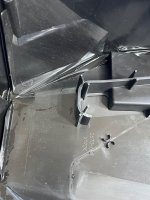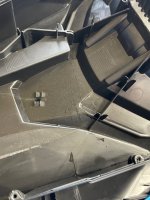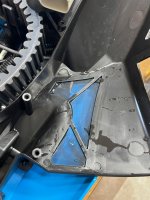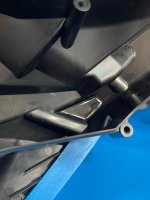Spiking a stock engine with 100LL is like adding water to your whiskey. It'll tame it down and certainly isn't gonna "spike" anything.and also spike it with some 100LL.
Install the app
How to install the app on iOS
Follow along with the video below to see how to install our site as a web app on your home screen.
Note: This feature may not be available in some browsers.
You are using an out of date browser. It may not display this or other websites correctly.
You should upgrade or use an alternative browser.
You should upgrade or use an alternative browser.
Water ingestion causing engine failures?
- Thread starter Vern
- Start date
Yeah, not all the fuel from the injector will end up the cylinder in lower throttle conditions. I don't know enough to say exactly what's happening, but either the intake pulse gets back to the cylinder before the piston passes the transfer port, or there isn't enough velocity to pull all the fuel from the injector into the cylinder, or some combination of the two. So you get some fuel/pre-mix in the case at idle and part throttle. A fairly small proportion though; nothing to compare to TB injectors or carbs.can you describe what you mean by backwash?
100%. It's only needed with high compression heads (and usually you'd try to avoid going high enough to need it) or if you've got a turbo and are running higher boost than the engine can handle without detonation on pump gas. Some engines (like the early Dragon 800s) were a little aggressive with compression, and 20% or so 100LL gave you some safety margin, but it didn't enhance performance. Adding it to an engine that doesn't need it costs you money and HP.Spiking a stock engine with 100LL is like adding water to your whiskey. It'll tame it down and certainly isn't gonna "spike" anything.
It will raise the octane some. Nothing more, nothing less.Spiking a stock engine with 100LL is like adding water to your whiskey. It'll tame it down and certainly isn't gonna "spike" anything.
I don't trust pump fuel, would rather have a cushion. Have seen to many post about Det Codes.Spiking a stock engine with 100LL is like adding water to your whiskey. It'll tame it down and certainly isn't gonna "spike" anything.
Damn! Can you show where those 4 spots were on the outside? Assuming all were along the seam?Mine had a ton of water in it there were 4 spots you could see through. Pulling the intake was a pain.
Can you get at all of the screws without actually pulling the intake? It looks like there's a labyrinth/lip all around, except for where the screws are (stupid design). If one can get at the screws, one should be able to inject RTV onto the flat surfaces through the screw holes. In theory, anyway.
A
automag1
Active member
Even after silicone it still had a small gap, so I added some to the outside.Damn! Can you show where those 4 spots were on the outside? Assuming all were along the seam?
A
automag1
Active member
There are some screws behind the steering stem you would not be able to get out the vertical runs are what mostly leak it took me about 5hrs to do it.i tried sealing it without pulling the box but it didn't help.Can you get at all of the screws without actually pulling the intake? It looks like there's a labyrinth/lip all around, except for where the screws are (stupid design). If one can get at the screws, one should be able to inject RTV onto the flat surfaces through the screw holes. In theory, anyway.
I pulled my hood off last night. 3 bomber over the hood snow days in Cooke City last weekend and there was not a drop of water in my intake. I did add a 1/2 foam seal on the upper plenum where is meets up with the rubber gasket on the lower intake box. I also removed the rubber gasket and glued it back down with RTV.
But that doesn't take away from those that are finding water in their air box. Those gaps shown above are bad. Kind of sucks it's so much work getting that box out to address that. I'm sure it all depends on the type of snow too. If you are riding super cold dry blower snow, I can see how water is getting in the air box.
Any rumors of BDX or anyone working on a filter, like their Protect Air?
But that doesn't take away from those that are finding water in their air box. Those gaps shown above are bad. Kind of sucks it's so much work getting that box out to address that. I'm sure it all depends on the type of snow too. If you are riding super cold dry blower snow, I can see how water is getting in the air box.
Any rumors of BDX or anyone working on a filter, like their Protect Air?
Last edited:
It’s odd that after all the crap with the proclimb/ascender sucking snow, cat finally sealed the intake towards the end of that chassis, but didn’t think it was worth adding the seal to the seams on the catalyst just for piece of mind.
No water in my lower air box. But was surprised how much water was in the upper plenum when I split it apart. I guess it’s designed so water can’t easily get in the intake box, but……
Attachments
Didn’t wanna make a new post about the the new latest theory I’ve seen on faceyspace about engine failures, so I figured here is a good place. The theory is that some sleds are coming out of the factory with zip ties extremely tight around the oil lines and pinching them off reducing oil flow to the bottom end.
I saw that post, guy claimed there's a service bulletin coming to check itDidn’t wanna make a new post about the the new latest theory I’ve seen on faceyspace about engine failures, so I figured here is a good place. The theory is that some sleds are coming out of the factory with zip ties extremely tight around the oil lines and pinching them off reducing oil flow to the bottom end.
Similar threads
- Replies
- 2
- Views
- 3K
V
- Replies
- 0
- Views
- 417
H
- Replies
- 22
- Views
- 4K
M
- Replies
- 11
- Views
- 4K
D











